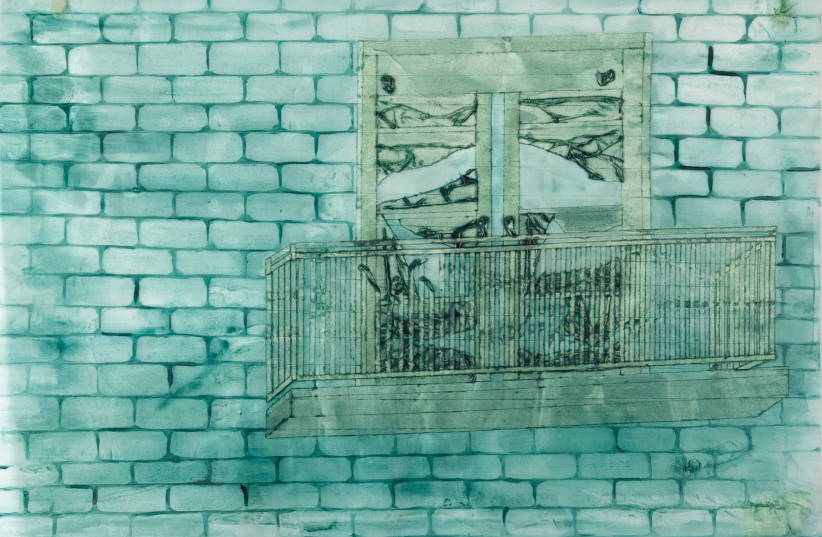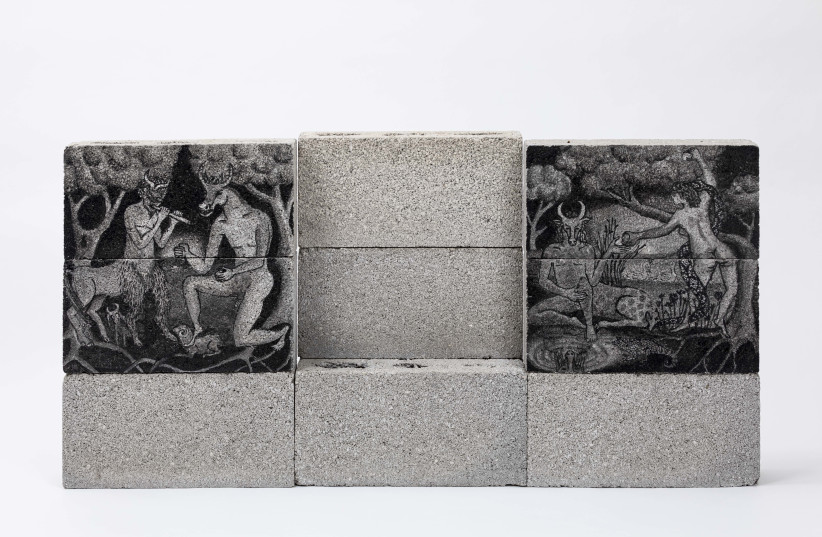They do say no pain, no gain. That is generally associated with sports and the idea that, if it doesn’t hurt, you aren’t giving your muscles a proper workout. In cultural domains, artists often liken the process of creation to something akin to labor pains. After all, they are giving birth to something which, before they got down to their canvas, potter’s wheel or, say, sculptor’s block of clay, simply did not exist.
That is very much part of the thinking behind the latest bunch of exhibitions that opened at the Jerusalem Artists’ House last weekend, although that leans more toward the personal experiential and philosophical side. In fact, all four exhibitors went through the mill at some stage in their own lives, as well as part of the creative continuum.
The tetrad includes Yael Sloma, Tal Golani, Sapir Gal and Zohar Alef. Each followed her own road to artistic and personal expression, invoking a range of materials, disciplines, and visual and spatial means to convey her take on some of the obstacles and trials life has thrown in their direction.
Sapir Gal's Souvenir Shop
SAPIR GAL’S show encompasses the whole life cyclic kit and caboodle. She calls her layout Souvenir Shop, curated by Bar Goren. The title intimates an artificial, marketing-oriented aesthetic with items – or products – that display a patina that suggests we are looking at a perfectly socially acceptable item when, in fact, there is a darker altogether less salubrious subtext to the whole affair.
“All the exhibitions engage in crisis or memento mori, like Sapir,” explains Jerusalem Artists’ House director Ruth Zadka. The latter, which means “remember that you have to die” in Latin, is an artistic or symbolic concept that serves as a reminder of the inevitability of death. It may not be the jolliest of thoughts to entertain, but it is an inescapable fact that, in general, Eastern cultures do a far better job of embracing than consumer, material, technologically-advanced Western society. Gal does her best to depict that existential altruism in as interesting and varied a manner as possible.

Her paintings and drawings delve into the idea of the inexorable time line as disintegration and decay set in. But they also address the idea of capturing vignettes along the way which, of course, don’t – cannot – recur. There is also an ecological aspect to Souvenir Shop, as Gal features natural materials alongside manufactured items such as soaps.
The Amber two-parter is a good reference point for that. The diptych shows a couple of earrings. At first glance, they appear to be just fetching fashion accessories, but there is an analytical side to the work designed to get us to take a more discerning look at our corporeal being and how we present it to the world. Each ear appears on a different canvas, thereby deconstructing and decontextualizing the body.
There is also the matter of how far we are willing to go in order to achieve what we feel fits the social pressure bill. How much effort do we invest, not to mention actual physical suffering, before we are finally ready to step out of our door every day to meet the world? “There are subtle references to body parts, parts that are incorporated into objects,” Goren notes, “objects that are scattered around the souvenir shop.”
There is a delicate living-dead, or man-made, yin-yang balancing act throughout Gal’s exhibition in both visual and conceptual terms. Amber exemplifies that and more. “Amber is a natural substance, in fact, sap, which contains a moment, a frozen stage of life,” Goren continues as we get up close to the twin piece. “The stagnant life here reminds us that the moment has passed and can never return.”
That, surely, is a given but it does make for sobering consideration and enlightening food for thought. The same goes for Gal’s nods to an aquarium environment in which the fish are seemingly provided with their every need – water, oxygen and food – but, looking in from the outside, those are clearly unsustainable living conditions in the grander scheme of things.
It suggests a sense of hubris as we blithely go about our business, taking little heed of the facts of life and impending cataclysm. Betwixt the precision and symmetry, beauty and the sublime in her creations, Gal generates tension between the meticulous aesthetics and their subject matter.
Yael Sloma's Payday
THESE DAYS and, presumably, for some time to come, there is no getting away from the fallout of the past two to three years. That is in full view in Sloma’s exhibition, Payday, which also treads a fine line betwixt the cause-and-effect relationship concerning the way we routinely live and the possible disastrous implications for further human existence on planet Earth.
Payday, curated by Tali Ben-Nun, comprises three installation or installation-like works: a large tiled woodcut called The Last Judgment; a linocut linear set called Danse Macabre; and an engaging video-sound amalgam called Four Horsemen. They all cite our quotidian dynamics, on both an interpersonal and individual level.
There is also a religious theme to the spread, with Sloma dipping into far-flung times for some of her inspiration as she sought to embrace a universal concept. “This series started out from a very different place,” she says as we approach the monochrome linocut walks. “I looked to [Hans] Holbein the Younger, from the 16th century,” she adds.
The German artist’s The Dance of Death woodblock printing set comprises a series of action-packed scenes in which the Grim Reaper does his rounds, collecting the souls of all and sundry, regardless of social standing or other niceties, when their number is up.
“There are all sorts of people in Holbein’s woodcuts,” Sloma explains. “There is an aristocratic lady, a sailor, a king, a baby, people from various professions, all ages. Death comes to everyone.”
That, the artist notes, is an elemental part of the religious tenets of the day. “Protestantism believed in the individuality of death. That it doesn’t make any difference how much money you have or where you come from – death will eventually get to you.”
“Protestantism believed in the individuality of death. That it doesn’t make any difference how much money you have or where you come from – death will eventually get to you.”
Yael Sloma
The commonality of human fate lies at the core of the linocuts, too, although all the figures in the diminutive pictures are alive, at least on a corporeal level. On a spiritual-emotional level, the situation is less clear. Each of the subjects appears to be holed up within their own four corners. There is a sense of claustrophobia and hiding away from the big wide world.
Perhaps this is where the sociological and emotional detritus of the pandemic lockdowns rears its ugly head. “I made these during the coronavirus era, when I was also closed up at home,” Sloma says.
But it is not just about that. There is a wider message here, about contemporary lifestyles and the way in which technological advances, some of which came into their own during the lockdown stretch, dictate the way many of us work and play. All the figures have their eyes glued to a cellphone screen or computer screen. They all seem to live in comfortable circumstances and have no interest in events going in the outside world. A living death, perhaps?
There’s also an ecological slant to the Danse Macabre subtext. “There are all these guilty feelings about ordering takeaways [during the lockdowns], and all the disposable utensils and plastic boxes which are thrown away at the end of the evening,” says Sloma.

The curator feels there is a seesaw oxymoronic factor to the set. “You have all these people on their home patch, where they should feel the safest, but there is also something threatening about their surroundings,” Ben-Nun observes. They are pretty dense compositions too, and that adds to a pervading feeling of unease.
The home delivery service networks, which did pretty well for themselves while most of us were forced to stay indoors, are referenced in Four Horsemen. The video installation features motorbike riders documenting on social media some of their two-wheeler antics at various out-of-town spots. There is a neat connection between the delivery bikers referenced in the lino cuts and the four-screen video work.
There is also a social statement to be made. “There is something almost pornographic about how the bikers show off their bikes, lights, gloves, helmets, accessories and stuff,” says Ben-Nun. “They are all competing with each other. But when something bad happens, they all rush to help.”
Tal Golani's Givat Ye'arim
WOLT GETS a mention, of sorts, in Tal Golani’s Givat Ye’arim installation. Golani deftly blends the idea of permanency and monumental presence with the fragility of transience. The biker delivery service is subtly referenced in a disorderly pile of light blue blocks which, in fact, are lightweight elements made of painted masking tape. There is more blue in her tribute to the yesteryear luxury Genossar Hotel, which started out in British Mandate era Tiberias as the Elizabeth Hotel.
There is grief and mourning in the portrayal of once grand edifices ravaged by neglect and the passage of time, particularly the large-scale grid-like arrangement of sections of a building façade on colored tracing paper. The latter is a salute to Golani’s late grandmother, who worked as an engineer. There is a particularly loving delicate mention of the artist’s forebear in an ethereally arranged strip of masking tape, which somehow manages to give a pretty convincing impression of the office chair her grandmother used when she worked her professional magic.
Golani’s expansive exhibition, curated by Neta Gal-Azmon, goes by the name of Unsought. It feeds off feelings of loneliness, abandonment and rupture, taking one’s leave of loved ones, and of nostalgia.
The three buildings in Unsought have seen better times. However, in the case of the Givat Ye’arim project, which started out around 40 years ago with such high hopes, only to be cut off in its prime, there are now grounds for hope of a better future. The rambling building was recently purchased by a new investor, so perhaps there is a happy end in store at least for one of the three.
Zohar Alef's Caesurae
ZOHAR ALEF’S Caesurae mixed-media installation, in the regular Nidbach area on the ground floor, maintains the emotive theme. As with the Golani show, there is a powerful family connection here. A dark secret that came to light in Alef’s family led the artist to dig into the tale, deconstructing and reconstructing some of those close to her in a quest to gain some new understanding.
Nidbach, a space reserved for young artists, is traditionally a site-specific affair. Caesurae takes its aesthetic line from the stone reliefs at the front of the Jerusalem Artists’ House building created by painter, decorative artist, and industrial designer Ze’ev Raban, one of the pioneers of the Israeli art world.
The installation comprises industrial construction blocks laid out across both rooms. Some feature parts of the faces of various members of the artist’s family, allowing her to scrutinize the details and possibly find new meaning. Alef took a leaf out of the psychoanalytic field, particularly from the writings of celebrated English psychoanalyst Wilfred R. Bion, who believed that one needs to paradoxically examine falsehood in order to come to terms with the truth. ❖
The artists will give gallery talks, in Hebrew, at various junctures of the exhibitions, which are due to close on May 27.
For more information: (02) 625-3653 and www.art.org.il
